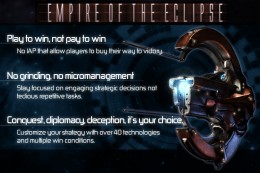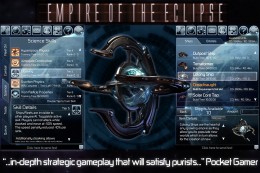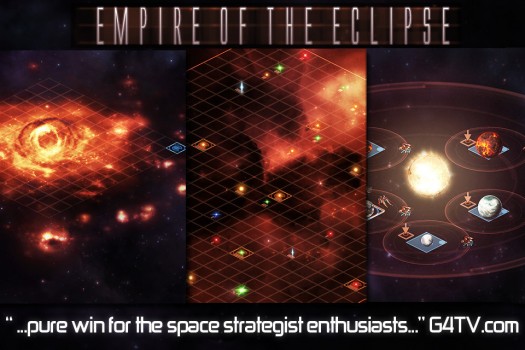 When I woke up this morning, the first thing I did was roll over and check to see if anyone had invaded my corner of the universe. Before I brushed my teeth, I queued technologies to research. At lunch, I sent my probes across the galaxy in the hopes of finding mineral-rich planets that would nourish my growing empire the way strange-tasting goulash was nourishing my body. I had to be prepared. It was still early, but soon there would be people looking to circumvent my attempts to create a few black holes.
When I woke up this morning, the first thing I did was roll over and check to see if anyone had invaded my corner of the universe. Before I brushed my teeth, I queued technologies to research. At lunch, I sent my probes across the galaxy in the hopes of finding mineral-rich planets that would nourish my growing empire the way strange-tasting goulash was nourishing my body. I had to be prepared. It was still early, but soon there would be people looking to circumvent my attempts to create a few black holes.
Empire of the Eclipse is huge. You’ve probably heard that word used in conjunction with this subscription-based strategy-MMO many, many times before but that’s because that’s the only adjective that really fits. Designed to be played over the course of weeks or months, each game in Empire of the Eclipse (Free) is capable of supporting hundreds of power-hungry players, all of whom will be laboring to achieve their respective ‘win’ criteria before anyone else can succeed at theirs.
As you might have guessed already, it isn’t easy. Between negotiating uneasy treaties and dealing with interstellar adversaries, you’re also going to have to manage your armada, build an array of orbitals, engage in trade, terraform planets, mine ore, fiddle with skill trees and more. On top of all that, you’re also going to have to work towards your end goal, a goal that can be anything from the accumulation of exorbitant amounts of wealth to the collapse of the very stars themselves.
It’s a lot to take in but Zarksoft has made everything a bit more palatable by structuring the game so that it’s best experienced in brief, 10-minutes bursts. Nothing in Empire of the Eclipse is about instant gratification. If you want to get anything done, be it move a probe from one sector to another or install the knowledge of advanced metallurgy into your people, you’re going to have to be prepared to wait. Even the destruction of someone else’s home-world is not something you can immediately savor; they’ll get twenty four hours to oust you from their planetary crib.
 Now, while this sounds like the perfect set-up for those ‘pay to get things done right this damn instant’ sort of scenarios, Empire of the Eclipse is not a freemium game in disguise. Everyone gets to stand on equal footing. No matter how much you want to hurry things along, you’re going to have to wait like everyone else. But, that’s enough talking about the game in the macro. How does Empire of the Eclipse actually play? The short answer is: slowly.
Now, while this sounds like the perfect set-up for those ‘pay to get things done right this damn instant’ sort of scenarios, Empire of the Eclipse is not a freemium game in disguise. Everyone gets to stand on equal footing. No matter how much you want to hurry things along, you’re going to have to wait like everyone else. But, that’s enough talking about the game in the macro. How does Empire of the Eclipse actually play? The short answer is: slowly.
Empire of the Eclipse isn’t one of those fast-paced, hair-trigger games that will have you jumping all over your iPhone. It doesn’t help that the learning curve is less of a gentle arc than it is a near vertical incline. Unless you’re the sort who is patient enough to sit through a hodgepodge of somewhat inelegantly designed video tutorials, chances are that you’ll spend those first few days flailing confusedly about, something I’m unfortunately well-acquainted with.
However, if you’re willing to persevere through that initial phase, the game will eventually open up. (A disclaimer: everything you’re about to read comes from the perspective of a budding mad scientist. It’s entirely possible that the playing experience will differ if you’re the sort who needs to marshal up the Death Star or something.)
 You begin life with but one solar system in your dominion, a single home colony and a host of outposts. From there, it’s your job to expand even further. The first order of business is, in general, to create a platoon of fragile, fast-moving probes so as to be able to explore the space around you.
You begin life with but one solar system in your dominion, a single home colony and a host of outposts. From there, it’s your job to expand even further. The first order of business is, in general, to create a platoon of fragile, fast-moving probes so as to be able to explore the space around you.
Building them is relatively easy. First, you’ll need to head down to a colony with the necessary facilities. From there, it’s as simple as tapping on the factory icon in order to access your production line and then tapping on the image of the probe in order to catalyze its creation. After that, it’s simply a question of waiting. (Told you there’s a lot of that here.)
I’m going to take a moment here to note that fans of finger swipes and pinches will likely be disappointed with the game’s control scheme. Everything in Empire of the Eclipse is generally accomplished with a tap or a double-tap, depending on which menu you have open. Needless to say, given the abundance of menus and elements to worry about, Empire of the Eclipse doesn’t really let you get your hands dirty. Instead of leading your troops into the thick of battle, you’re going to be responsible for deciding their routes, what kind of technologies they’re going to have and how best to optimize the usage of your many factories. In that respect, you’re more of an overseer than an overlord.
 Speaking of technologies and skill trees, the system utilized in Empire of the Eclipse is one that will likely be familiar to Eve Online veterans. Like the creation of ships, you conduct research by tapping on a skill in order to add it to the queue. Once you’ve accomplished this, you will have to, yet again, wait until it is completed. (Of course, you can queue several skills at the same time but that’s neither here or now.)
Speaking of technologies and skill trees, the system utilized in Empire of the Eclipse is one that will likely be familiar to Eve Online veterans. Like the creation of ships, you conduct research by tapping on a skill in order to add it to the queue. Once you’ve accomplished this, you will have to, yet again, wait until it is completed. (Of course, you can queue several skills at the same time but that’s neither here or now.)
Separated into four different branches and six tiers of research, the skill trees available to an Empire of the Eclipse player are as follows: trade, science, combat and fleet control. In general, the names are self-explanatory. The trade skill tree, for example, deals with things like allowing your mining colonies to produce rare ore, the ability to cause your trade ships to explode violently should they be compromised and even the study of piracy. In short, it is designed to make you a bartering powerhouse. One thing I particularly liked about how they’ve approached the whole skill trees thing is the fact that you are not limited by your chosen specialty. . Even if you’re a researcher, nothing will stop you from developing that omnipotent armada. Want to build your solar taps after you’ve demolished every other player in the game? Sure! There’s nothing stopping you.
In between all of this research and fleet generation, you’re also going to worry about having enough ore to facilitate all of your activities, something you’ll be able to accomplish by doing anything from colonizing new planets to establishing trade routes to commandeering occupied solar systems. It’s all up to you.
If all this kinda sounds like a dream come true, you’ll be mostly right. Empire of the Eclipse is a massive, sprawling affair that will keep you busy for weeks. It’s the kind of MMO that serious-minded iOS gamers have been waiting for, the sort of game that will draw a trill of appreciation from Angry Birds haters. If you have the right mindset, Empire of the Eclipse will rock your world.
That said, it’s also far from perfect. The interface is a little too cramped, the writing occasionally breaks out of character (just try to destroy an orbital platform, I dare you), and the game is still far too empty. During my experiences with the tutorial server, I found myself sadly bereft of company. To be fair, it might have had something to do with how I wasn’t really ready to venture out myself prior to being able to do some some heavy damage to any encroaching hostiles but that does not change the fact I didn’t get any house calls myself. Asides from that, the game was also plagued with inexplicable glitches and bugs. For no reason at all, it would crash or disconnect. Though it has improved since then, I still find myself stumbling across these kinds of issues.
Long story short, Empire of the Eclipse is (or, at the very least, will be) well worth that subscription fee. Whether or not it will succeed at fully realizing its ambitious promise hinges on if the game is capable of achieving that critical mass integral to any good MMO. The only other caveat is that you’ll probably spend an inordinate amount of time learning the game (text-based tutorial? In-game wiki? Any sort of alternative to the video tutorial? Please?) first. Nonetheless, if you’re willing to go through all that , Empire of the Eclipse will probably be that massively multiplayer ‘Master-Of-Orion in a pocket’ experience you’ve always longed for. Just hold onto that urge to jump for a year’s subscription a little longer.

